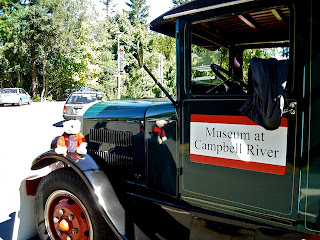At Campbell River, I kept stumbling upon
wonderful things.
British Columbia’s Campbell
River flows out of Buttle Lake
on Vancouver Island. It reaches the
sea about 100 kilometres to the east, at a narrow strait called Discovery Passage that churns and boils
with powerful tidal currents.
All five kinds of Pacific salmon – chinook, coho, chum, sockeye, and pink – swim
in the Campbell River. The salmon are born from eggs in the river’s fresh water.
After two to six years living in the salty sea, they return to the Campbell to
spawn.
As a Kermode bear, I was born
to fish, and I know good fishing when I see it! Sure enough, I soon met people having
lots of luck fishing for salmon along the banks of the river.
Other people put on wetsuits and snorkels, and swam with the
salmon right in the river.
A doctor in Britain’s Royal Navy gave the Campbell River its
name. Dr. Samuel Campbell was a
surgeon aboard HMS Plumper between
1857 and 1862. Dr. Sam must have been good at his job, with grateful patients:
Campbell Island, Campbell Point, and Campbell Bay are also named in his honour.
First Nations have known about the good fishing here for
thousands of years. The Kwak’wala name for the river is Tla’mataxw.
By 1900, Europeans had begun settling at the
mouth of the river. Now a booming community of over 31,000 people, the city of
Campbell River built its wealth on natural resources: logging, pulp and paper,
hydroelectric power, mining, and fishing.
Hmm, let me add to that list of resources: incredible
scenery, magnificent parks, all kinds of wildlife and birds to see, hiking,
river-rafting, whale-watching …
It was the fishing in particular that brought me to Campbell
River on this trip. Over the last century, many of the town’s visitors would
have said the same. Campbell River boasts the historic nickname Salmon Capital of the World!
Discovery Pier is
a huge public wharf on Discovery Passage. You can fish for salmon right off the
pier.
The southern end of Discovery Passage opens onto the Strait of Georgia. The passage was
named after one of Captain George Vancouver’s
ships, HMS Discovery. Captain
Vancouver surveyed what is now B.C.’s coastline between 1792 and 1794.
Hey, look at that
pretty ship! It belongs to B.C. Ferries.
Every hour during the day, the
85-metre-long Powell River Queen travels
across Discovery Passage from Campbell River to Quadra Island. The ferry can carry up to 68 cars and 400 people at
a time.
The fisher in my soul loved this wood carving near Discovery
Pier. It represents a kind of salmon-fishing lure called a plug:
There are wooden carvings like it all along Campbell River’s
seaside. The Campbell River Shoreline Arts Society sponsors an annual
competition of wood-carving. This
work won in 2000:
and this sculpture won in 2004:
It’s called “The Light Watchman,” and it’s at the Maritime Heritage Centre, a museum that celebrates Campbell River’s connection to
fishing and the sea. What do you
think the sculpture represents?
This beautiful shelter is in Campbell River’s waterfront
park. It’s called Robert V. Ostler Park,
in honour of a city mayor.
Campbell River takes good care of its public sculptures. I
totally behaved myself around them, but anyone who didn’t might find
himself locked into the pillory!
Now, have you ever heard of latitude
and longitude? Those are the
imaginary lines you see drawn on a globe to create a grid. The grid lets you
describe where things are.
Lines of latitude circle the Earth parallel to the equator. Campbell
River is 50 degrees of latitude north of the equator … and that’s why this great band is
called Fiftieth Parallel!
See, geography helps me understand all kinds of surprising
things.
I stumbled upon Fiftieth Parallel playing a set at Spirit Square in downtown Campbell River
one lunch-hour. There’s lots of good
shopping downtown, too. Suzanne especially lost track of time at shops called Serendipity in the Garden, and Mussels & More Pottery.
This handsome bear is named Blackberry:
I stumbled across him
at the amazing Museum at Campbell River.
I wanted to learn more about Campbell River’s history and
prehistory, First Nations, logging, and fishing. And I happened to stumble on
an extra-special day at the Museum, when volunteers stoked up a historic steam donkey.
This startling contraption is a steam-powered winch that loggers used to drag fallen
trees through the woods.
Steam-power means
that wood has to be burned to boil water in the engine.
The Museum has a sweet collection of old logging trucks,
too.
This blacksmith
was demonstrating how to heat iron over a fire, then hammer it into shape on an
anvil:
In a logging camp, the blacksmith would always be busy,
making horse-shoes or repairing logging equipment. In the middle of the forest,
you couldn’t just go to a hardware to buy spare parts.
You can explore an archive of old photos about logging
history on the Museum’s website. I especially like the photos about Camp Life – imagine growing up in a
remote logging camp!
This is Alex Witcombe,
an artist who drew a picture of the Museum’s steam donkey in chalk on the
sidewalk.
The Museum also had a special exhibit inside at the time of my visit –
about fishing at the mouth of the Campbell River. Just next to a spit of land in
the river’s estuary, the Tyee Pool
has earned a special place in Campbell River’s sportfishing history. And I’ll
tell you more about it in my next post.
Story and photos © S. Clouthier
Map of Discovery Passage courtesy Pfly / Wikipedia
Map of the Earth courtesy Simple English Wikipedia





































No comments:
Post a Comment